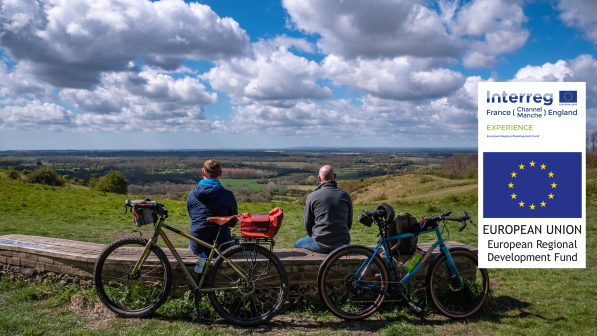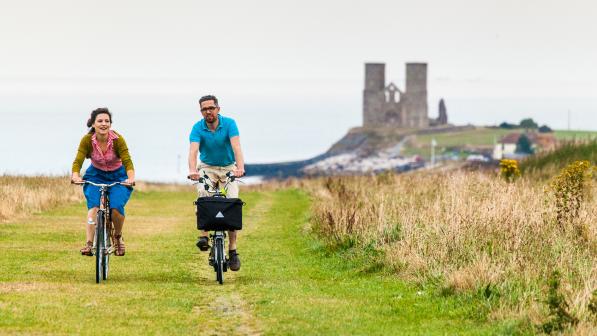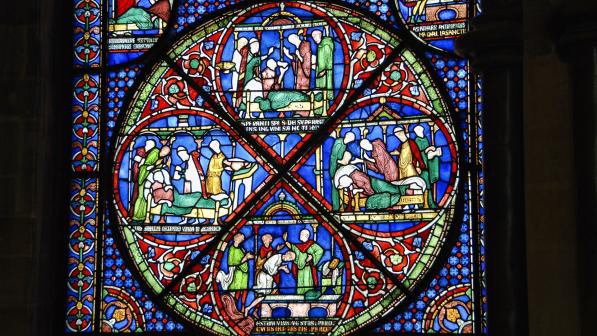Experience Canterbury: Cathedral Cycle
Stats: 24.8 km (15.4 miles) with 310 metres of climbing
Start location: Christchurch Gate, in the centre by the Cathedral, CT1 2HX or Longport car park, off the A257 road and St Augustine’s Roundabout.
Route overview
This route uses a mixture of cycle paths, quiet roads and bridleways making it suitable for gravel, hybrid and mountain bikes, and visits no less than three UNESCO World Heritage Sites: Canterbury Cathedral, the ruins of St Augustine’s Abbey and the Church of St Martin.
After a rich historical start to the ride, the route guides you out of the busy city centre and plunges you into the beautiful, quiet countryside where you will enjoy leafy tracks, orchards and a ford. After a choice of refreshments at some excellent cafes and country pubs along the way, the route then guides you back along traffic-free cycle paths, into the bustling centre of Canterbury along its amazing narrow historical streets, for a wonderful and varied journey.
This is one of three routes starting from the Cycling UK EXPERIENCE hub in Canterbury.
Have a look at the other routes: Canterbury to Coast and Canterbury to Chilham.

Christchurch Gate
Starting outside the cathedral is lovely, but be prepared for busy streets, especially as the day unfolds. If arriving by car, the Longport car park is close to the centre and easy to get to, although quite pricey.
We start at Christchurch Gate by Canterbury Cathedral, one of the oldest and most famous Christian structures in England. This stunning mixture of Romanesque and Perpendicular Gothic architecture is well worth visiting properly off the bike. It was built around 597 AD, and pilgrims and visitors have made their way to see this sight since the Middle Ages. The Benedictine tradition and warm hospitality continues today, with daily morning and evening payer and Eucharist (Holy Communion) which all are welcome to join.
The Archbishop of Canterbury is the principal leader of the Church of England and the worldwide Anglican Communion owing to the importance of St Augustine, who served as the apostle to the pagan Kingdom of Kent around the turn of the 7th century. The cathedral became a major focus of pilgrimage following the 1170 martyrdom of Thomas Becket, although it had already been a well-trodden pilgrim destination since the murder of St Alphege by the men of King Canute in 1012.
From outside the wonderful Christchurch Gate (and a rather bright, garish American Candy shop) by Canterbury War memorial, this is no doubt the busiest place in Canterbury so you may need to proceed slowly and carefully along the street to start.

Saint George’s Tower
This will allow you to enjoy the beautiful street, lined by amazing old timber buildings as you go though, until you arrive in a more modern part of the city where just one building from the city’s past remains standing: Saint George’s Tower.
Dating back to Norman times, although the present tower is 15th century, on the 1st June 1942 Canterbury suffered its worst bombing raid of WWII where almost every building in this area was destroyed, leaving just this tower and clock from the medieval city.
St Augustine’s Abbey
As your ride starts to head out of the city centre, just outside the city walls you pass the ruins of St Augustine’s Abbey, once a burial place for the Anglo-Saxon kings of Kent. At its height in the Middle Ages, it was one of the most significant religious houses in Northern Europe and brought about the rebirth of Christianity in Kent after the departure of the Romans. You can even experience the Abbey as it would have appeared in the early 1500s via a virtual reality headset, allowing you to 'walk' through parts of this 16th-century monastery.

St Martin’s Church
You have barely turned the pedals before you’re passing a cycle lane which leads you to the next, and third, UNESCO World Heritage Site of the day: St Martin’s Church, the oldest church in the English-speaking world. St Martin’s was the first base for Augustine, a Benedictine monk from Rome, who arrived to the UK in 597AD with 40 companions, including Roman monks and Frankish interpreters, to preach the news of Jesus Christ.
Patrixbourne loop
Now joining The North Downs Way Trail, you then head out of the city, following good tracks across the open, agricultural land, to the village of Patrixbourne, where an optional, but rewarding loop awaits.
After passing through (or beside) the ford, a stiff climb delivers you to a pleasant bridleway that runs beside a wood, and then the A2 road, before peeling off into the industrial park of Highland Court Farm. Tucked away at the back is the wonderful Independent Pedaler (cyclist) café, which serves up some brilliant refreshments, with a nice indoor and outdoor area, and bike racks.
Exiting out of the back of the estate you join a bridleway which guides you through an orchard and past a cricket ground. Crossing back over your route from earlier, you descend through and then beside the woods, back to Patrixbourne. This lovely little village is home to the beautiful St Mary’s church Patrixbourne, with its Norman architecture, a wonderful arch doorway and Wheel Window with Swiss stained-glass panels.
Oast houses
There is a nice café worth a visit in Chalkpit farm at Bekesbourne, and then after crossing the railway bridge in the field, look left and you will spot a number of concrete pyramid blocks used to defend against tank attacks during WWII. After crossing the grassy field you then join a good farm track across the exposed valley bottom, before climbing to the village of Littlebourne, where you’ll spot an oast on your right. Known as oast houses in Kent and Sussex, or hop kilns in Surrey, Hampshire, Herefordshire and Worcestershire, these are buildings designed for kilning (drying) hops as part of the brewing process, and are common in hop-growing locations such as Kent.

The ancient port of Fordwich
You will also find the wonderful Ivy Barn farm shop and café in the village too, which is well worth a visit. Quiet roads now lead you to Fordwich, a beautiful and ancient port on the River Great Stour. Although Fordwich has never boasted more than a few hundred inhabitants, its right to style itself as a town dates from 1184, when King Henry II granted it a Merchant Gild Charter, reflecting its importance as the de facto port for Canterbury. In the Domesday Book, it was described as a small burgh, one of only seven burghs in Kent.
The Crooked House of Canterbury
A cycle path beside the River Stour now guides you back to Canterbury through park and woodland, before back into the heart of the city. The interesting, narrow street of Northgate and high stone walls of King’s School feel almost claustrophobic after the space and freedom of the countryside, and then you face to see The Crooked House of Canterbury. This wonky 17th century half-timbered building (with a book shop located inside) had an internal chimney which began to lean, taking the building with it. Attempts to straighten the chimney caused the building to slide further, and although it doesn’t look safe, a steel frame now holds the building safely together.
You continue along the pretty Palace Street, between numerous, fabulous timbered buildings, shops and cafes, before you arrive back at the Christchurch Gate, to end your pilgrimage bike ride.


The development of these routes has been funded through EXPERIENCE, a €23.3 million project co-financed by the European Regional Development Fund (ERDF, €16 million) through the Interreg VA France (Channel) England Programme 2014-2020, boosting visitor numbers in six pilot regions across England and France. This project will harness the experiential tourism trend to extend the season (October – March), generating 20 million new off-season visitors spending €1 billion across the Channel region by June 2023.


